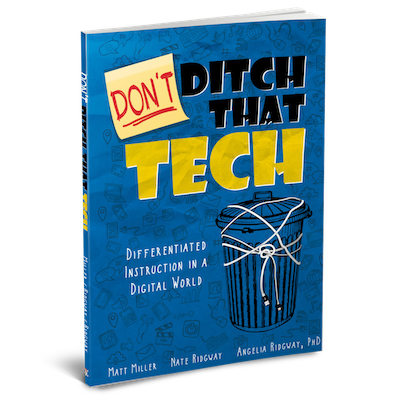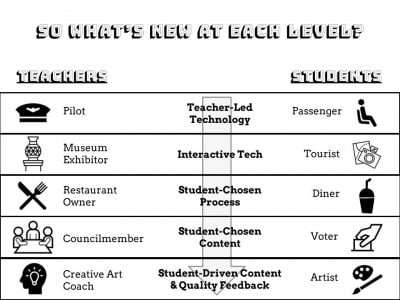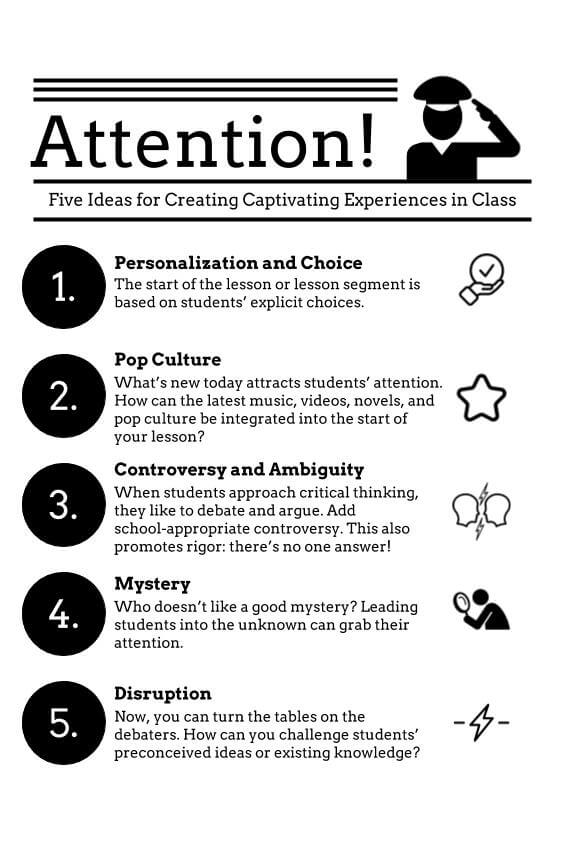
Are you ready to begin differentiated instruction? Ditching your technology isn’t the answer—finding the right tool, for the right teacher, for the right moment is!
 Differentiated instruction. Great tech use. They’re both doable — and they can work in harmony!
Differentiated instruction. Great tech use. They’re both doable — and they can work in harmony!
In this book that I co-authored with educators Nate and Angie Ridgway, we give TONS of practical ideas for differentiating well with technology.
Differentiation is something many of us wish we did better. Thankfully, the technology we have available to us can help us improve our classroom differentiation — and kick up the level of learning.
Below you will get a small taste of what you can find in Don’t Ditch That Tech with practical suggestions and links to examples.
We even differentiate the book for teachers of varying tech levels! In the book, you’ll take a survey to find out which type of teacher you are:
You can take that survey now for FREE — and read the first part of the book — by using the preview link below.
Get Don’t Ditch That Tech in paperback
Get Don’t Ditch That Tech for Kindle
Preview the beginning of Don’t Ditch That Tech now for FREE
Speaking of free … we have a great FREE bonus with the book! It’s “15 custom ‘app’etizers” — tech tools selected just for you based on your level of tech use!
Click here to get your 15 custom “app”etizers
5 ideas for creating captivating experiences in class
A sneak peek at Don’t Ditch That Tech!
1. Personalization and choice
Students want to see themselves in their learning. It helps them grasp the “why” of the lesson. When they get some choice — or some part of the lesson is personalized for them — it helps everything to hit home.
Example: Nate teaches a dual credit U.S. History class in Indianapolis and used this local example of eugenics to connect to student’s lives. Link: dontditchtech.com/eugenics
2. Pop culture
What’s new today attracts students’ attention. How can the latest music, videos, novels, and pop culture be integrated into the start of your lesson? The great part: you don’t have to totally understand — or even like! — very much of it. They’ll be glad to teach you whatever you need. The fact that you reached out to their interests will go far.
Example: This Twitter moment of Venezuela’s 2018– 2019 election really shows how this media combines audio, pictures, and video from multiple perspectives. Link: dontditchtech.com/election
3. Controversy and ambiguity
Controversy catches almost EVERYONE’S attention. Conflict is a key component in any story from books, movies and theater. Adding a layer — even a somewhat artificial layer! — of controversy can spark that interest. Ambiguity works like this, too. When there’s uncertainty on the end of a story or the answer to a question, it can get their gears turning. This also promotes rigor: there’s no one answer!
Example: America has a pretty complicated relationship with the rest of the world, to say the least. Using archetypes, students were able to have either a whole-group or small-group scaffolded discussion about this controversial topic after watching a TED Talk. Link: dontditchtech.com/archetypes
4. Mystery
Leading students into the unknown can grab their attention. There’s a sense of accomplishment when there’s a riddle to be solved and your skills were up to the task! One of the best parts of mystery — playing the part! Add to the suspense by describing and helping them see exactly what’s mysterious — and what’s so mysterious about it.
Example: These photos pull from students’ existing knowledge of Hitler, the Great Depression, and Europe’s colonization of the Western Hemisphere. Link: dontditchtech.com/photos
5. Disruption
How can you challenge student’s preconceived ideas or existing knowledge? In a world where truth and facts aren’t easy to discern, this type of activity helps them develop strong investigation and vetting skills.
Example: The teacher challenges students to think about the idea of fish not existing. Look at how promoting disequilibrium can prompt thinking! Link: dontditchtech.com/fish
For notifications of new Ditch That Textbook content and helpful links:
Are you looking for quality, meaningful professional learning that both equips and inspires teachers?
Matt provides in-person and virtual keynotes, workshops and breakout sessions that equip, inspire and encourage teachers to create change in their classrooms. Teachers leave with loads of resources. They participate. They laugh. They see tech use and teaching in a new light. Click the link below to contact us and learn how you can bring Matt to your school or district!
Is Matt presenting near you soon? Check out his upcoming live events!





